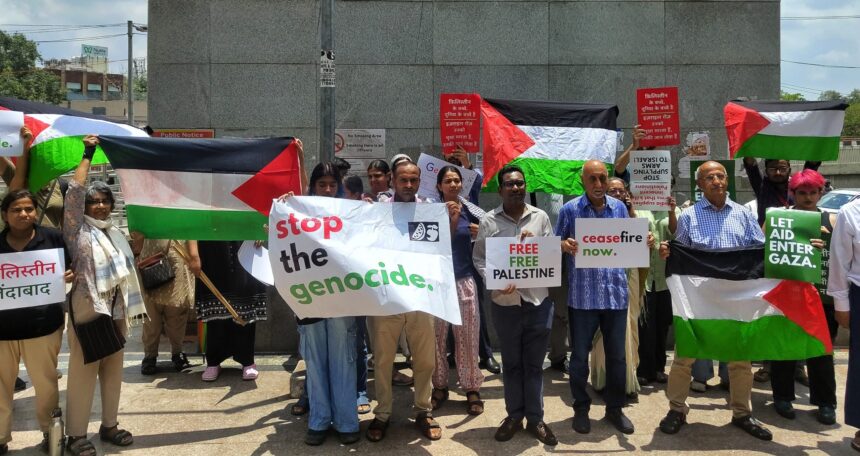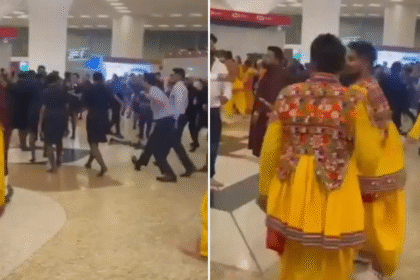From Bombay HC Order to Nehru Place Protest Disruption: How Free Speech Is Being Selectively Silenced
What is common between the Bombay high court and Nehru Place? A newly formed Hindutvavadi spontaneity masquerading as patriotism is what binds them.
We have seen, time and again, how in many parts of India, the police and Hindutva mobs often act in unison – especially when they are faced with or dealing with Muslims or Christians. But when the courts begin to use the language and logic of Hindu nationalism, it is time to worry. It means the water has already gone above our heads.
Two recent events serve as warning signs – one in Mumbai, the other in Delhi. The first was a comment from the Bombay high court; the second, the response of a crowd at Delhi’s Nehru Place. What links these moments is a distant but morally urgent crisis: the genocide being carried out by Israel in Gaza and how we should respond to it.
That question was answered by a courtroom in the Bombay high court and a street in Nehru Place. That explains the connection that could possibly be between a courtroom in Mumbai and a marketplace in Delhi.
‘Must patriotism be at odds with solidarity with the oppressed people?’
“Why raise your voice in India against the massacre of Palestinians? Don’t we have enough of our own problems?” – these were not the words of an angry passerby on the street. This was the Bombay High Court rebuking the Communist Party of India (Marxist) (CPI (M)), which had sought judicial permission to protest against Israel’s genocidal acts in Gaza after the police denied them permission.
Rather than defending their constitutional right, the court reprimanded the petitioners, advising them to “be patriotic” and focus on domestic issues. What, the court seemed to ask, should India’s citizens have to do with Gaza?
One may ask the court in return: Must patriotism be at odds with solidarity with the oppressed people ? Must caring for one’s country mean closing your eyes to the suffering of others?
To be told, “Be patriotic”– what does it mean? That we should become emotionally self-centred? That we should close our eyes and ears to what lies beyond our borders? The great thinkers and philosophers of the world never defined patriotism in such narrow terms. True patriotism is not exclusionary. It is not isolationist. Or is there something in the word “Palestine” that jars the patriotic Indian ear?
Some might argue that this was merely a judge’s offhand remark, not a part of the order. But it is precisely this spontaneity that should worry us. The ease with which someone assumes the authority to define who is and is not patriotic is itself a concern. More troubling still is the idea that patriotism requires one to be devoid of empathy for those outside national borders.
In dismissing the petition, the court gave a sermon: “Our country has enough issues to deal with. We do not want anything like this. I am sorry to say that you are short-sighted. You are looking at Gaza and Palestine while neglecting what’s happening here. Why don’t you do something for your own country? Look at your own country. Be patriots. People say they are patriots, but this is not patriotism. Show patriotism for the citizens of our own country first.”
The court suggested that the party would do better to protest against garbage, pollution, open drains. Matters such as Gaza, it said, are a matter of foreign policy – and therefore the domain of the government alone. The petitioners should not raise unnecessary dust in this filed which belongs to the government alone.
Critics were right to point out that the court seems to have lost sight of the Constitution. Indian citizens do not need the state’s permission to care for others, even those who are not their compatriots. Don’t we rush to the aid of people devastated by an earthquake in Turkey?
Apart from the right to have this human response, they have the right to hold and express their views. They do not deposit this right with the government. The right to oppose the official stance on Israel and Palestine belongs to the people – and cannot be taken away.
The collapsing boundary between the courtroom and the street is worrying
What was said in the courtroom in Mumbai was echoed by a crowd on the street in Delhi. Approximately thirty people had gathered at Nehru Place to protest Israel’s assault on Gaza, holding Palestinian flags. No sooner had they assembled than shopkeepers and passersby surrounded them , tore the flags from their hands, and demanded, “Where is your own country’s flag?”
This question –”Where is your own flag?”– is no different from the court’s reprimand: “Be patriotic! Why speak of a place thousands of miles away?”
The court did not do what the crowd did. It raised the slogans of ‘Bharat Mata ki Jai’ and ‘Jai Shri Ram’. Why did the the sight of the Palestinian flag provoke them to chant these Hindutvavadi slogans?
The Bombay high court wants the CPI(M) to talk about drains, pollution, unemployment. The crowd at Nehru Place wants protestors to speak of Hindus in Bangladesh. Fundamentally these two demands are not very different.
The collapsing boundary between the courtroom and the street is worrying. But more troubling still is the emergence of a new form of spontaneous nationalism – visceral, unthinking, and emotionally volatile. The crowd at Nehru Place wasn’t an organised crowd. Its members may not have belonged to the Bajrang Dal or RSS.
Yet, the sight of the Palestinian flag was enough to enrage them. Just as the mere mention of Gaza was enough to provoke the court. Neither reaction was planned or pre conceived , yet both were immediate, reactive, and ideologically charged.
These reactions resemble something we’ve seen elsewhere – in New York or London, for instance, where Israelis have attacked strangers on the street for wearing a keffiyeh or sporting a Palestinian flag . In India too, a growing number of people have developed a reflexive hostility.
The sight of a keffiyeh, a green flag, a burqa, a skullcap–or simply hearing the azaan – triggers rage. In Nehru Place, the crowd needed no provocation. It gathered spontaneously and demanded to see the Indian tricolour – just as the court demanded proof of patriotism.
Should we not call this ‘Hindutva spontaneity’? Is it natural for someone to erupt in fury at the sight of a flag of a different nation or the sound of prayer? In Nehru Place, it was the Palestinian flag. In Pune in 2014, it was Mohsin Shaikh’s attire that ‘provoked’ a group of men to kill him. The court showed sympathy for the attackers, citing their reaction as “spontaneous,” not premeditated.
A troubling contraction of the moral and emotional universe of a large section of Hindus in India
Since 2014, the scale of this spontaneous Hindutva response has only grown. Certain sounds, colours, clothes, even architectural forms now incite a particular kind of rage. Those who react no longer seem able to control themselves.
This marks a troubling contraction of the moral and emotional universe of a large section of Hindus in India. And that is deeply unfortunate – not for others, but for them. Because the essence of human sensibility lies in its ability to transcend the self.
Why are human sensibilities different than those of other animals? That we feel not just our own pain, but are moved by the pain of others. The image of a Vietnamese girl, burned by napalm and running in terror, shook us all. It did not require us to be Vietnamese. The human sensory apparatus, at its best, transcends bodily boundaries and leads us toward solidarity for others .
We are stirred not only by the poems of Ramdhari Singh Dinkar, but also by the verses of Mahmoud Darwish.
But today, a section of India’s Hindu majority seems to be losing this capacity of feeling. Starving children, bombed cities–they do not unsettle them. Instead, they laugh. And what kind of person would not be afraid of such laughter?
Also Read: Trump in Scotland: Russia Connections and Gaza Statements Draw Global Attention Before 2025 Polls








